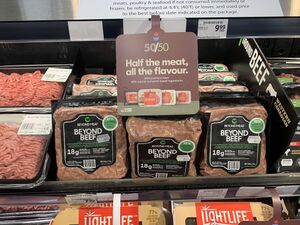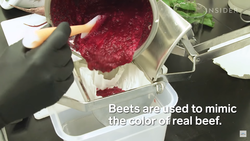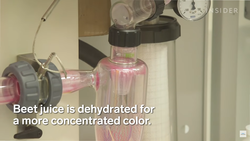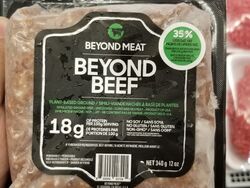Course:FNH200/Projects/2020/Beyond Meat: Nutrition, Sustainability, and Processing
Introduction
| Beyond Meat is a modern meat substitute that mimics the taste and texture of real meat (beef, pork, chicken, etc.) for the growing market of conscious consumers in our society looking for sustainable alternatives. The company has its roots in Los Angeles, California with production facilities in El Segundo, California and Colombia, Missouri. The founder, Ethan Brown, started the company in 2009. He was motivated to shift consumers towards eating plant-based meat substitutes for a more sustainable future. Beyond Meat’s mission statement from their website states that “by shifting from animal to plant-based meat, we can positively impact four growing global issues: human health, climate change, constraints on natural resources, and animal welfare.”[1]
Ethan Brown was a city boy from Baltimore who had farming in his blood.[2] After getting his MBA, he set out to create a product that would help fight two of the issues he cared about most: harming animals, and climate change. In 2009, Ethan embarked on his mission of eliminating chicken and beef from peoples’ plates and replacing it with plants, all while ensuring that taste was not being sacrificed. As such, Beyond Meat was born. When the product first launched in 2013, there was a frenzy to try it out. Products sold out rapidly across the American nation as hype around the company grew. In 2018, they opened a second production facility in Missouri tripling their manufacturing footprint. This allowed them to meet market demands in the USA and expand production to include 50 countries globally. Now, it can be found in over 20,000 retail locations around North America. The company has a 133% compound annual growth rate since 2016.[3] Still to this day, Beyond Meat is one of the fastest growing food companies in the United States due to the increasing market for meat-alternatives. In July of 2020, there was a 279.8% increase in demand for plant-based meat alternatives compared to July of 2019, increasing still from the 206.4% increase in market demand from the previous year.[4] Beyond Meat is becoming increasingly popular, this is likely in part due to the company’s mission and proven effectiveness to positively influence climate change. Compared to a single quarter-pound beef burger patty, a single quarter-pound Beyond Burger uses significantly less water (99% reduction), land (93% reduction), energy (46% reduction) and produces fewer greenhouse gas emissions (90% fewer GHG emissions).[5] With increased education of climate change and it’s related issues worldwide, it’s no wonder that conscious consumers are picking the meat-alternative option that doesn’t seem to compromise flavour or texture. Beyond Meat has partnered with many chains and restaurants including but not limited to: A&W, Tim Horton’s, Tesco (UK), Dunkin’ Donuts, Subway, Denny’s, Whole Foods, Costco, Save-On Foods, Safeway, Target, Walmart, TGIFridays, Carl’s Jr., DelTaco, ShopRite, and Sprouts. There are also several food chains and restaurants that have opted out of serving Beyond Meat because they are “too heavily processed” such as Chipotle CEO Brian Niccol.[6] Beyond Meat's products are undeniably processed foods, which is why the company employs a staff of scientists and food analysts that work year round on research and development in aim to simplify the processes needed to create alternative meats. Despite being relatively unknown outside of the vegan/vegetarian community and not turning a profit for the first few years of its existence,[2] Beyond Meat has entered the culinary lexicon of even the most carnivorous consumers, and has emerged as a true competitor in the meat industry. In Beyond Meat’s first ever TV advert Academy Award winning actress Octavia Spencer asks the question, “What If We All Go Beyond?”.[7] The ad suggests we could make friends with cows, take better care of our health and our planet, all while promising a “great burger”. Intrigued consumers that seek out Beyond Meat burger patties will pay nearly double the price at the till compared to ground beef patties.[8] Going meatless has become trendy as of late, with many people jumping on the Beyond Meat bandwagon, but how does it really stack up? Is plant-based meat really as environmentally friendly as we think it is? Is it safe? What are the differences in texture, flavour, nutrition, and shelf life compared to real meat? These are the important questions we will be answering in our project. |
File:Beyond burger.jpg Figure 1: Beyond Burger |
How It's Made
Ingredients
How did Beyond Meat make beef in a lab? As Beyond Meat states on their website, the five components of meat are protein, fat, minerals, carbohydrates, and water.[9] So, how are these building blocks replicated using only plant-based ingredients and is there a benefit to eating plant-based "meat"? Many people might assume that a vegan alternative to red meat would be better for their health, but is this really an aspect in which the lab-grown substitute does go beyond?
Protein
Protein is an essential part of our diet, and meat serves as an important source of this essential nutrient for many people. To substitute the animal protein found in beef, the makers of Beyond Meat use a combination of pea protein, mung beans, faba beans, and brown rice to deliver a comparable amount of protein to their animal-based counterparts.[10]
The Beyond Meat website states that by using a combination of plant-based proteins they are able to deliver “greater or equal levels of protein than their animal-based counterparts.”[9] However, when comparing the Beyond Burger to Kirkland Ground Beef Patties, Beyond Meat actually has 12% less protein per gram than the Beef Patty.[11] The amino acid profile of beef is also very important to its nutritional power, as it is nearly identical to that of our own muscles.[12] However, the unique combination of proteins that Beyond Meat uses does also create a complete protein that gives us all of the same essential amino acids that we need.[13]
Fat
Part of what makes meat so tasty and enjoyable to eat is the fat! Fat gives us a smooth mouthfeel, it carries pleasant aromas, and it makes that satisfying sizzle in the pan. Beyond Meat gets its plant-based fat from cocoa butter, coconut oil, and canola oil.[9]
One of the benefits of using plant-based fats outlined by Beyond Meat is that these products contain less saturated fats than beef.[9] However, in an article published by Harvard Health Publishing the authors state that meatless substitutes like Beyond Meat may actually contain higher levels of saturated fats which have been associated with health concerns such as heart disease.[10] When we compared the nutritional information of ground beef and beyond meat, we found that gram per gram, Beyond Meat did contain less saturated fat and less trans fat, even when controlling for the slightly smaller portion size.
Vitamins & Minerals
The minerals in meat that are important to our health include B12, Zinc, Selenium, Iron, Niacin, B6, and Phosphorus.[12] Calcium, iron, salt, and potassium chloride are listed on the Beyond Meat website as minerals in their product that are used to deliver the nutrition and taste that we expect from meat,[9] including iron which is important for preventing health concerns such as anemia.[12]
When we compared the nutritional information of Beyond Meat and ground beef, we found that there was a lot more information on the Beyond Meat label. This isn’t to say that these vitamins and minerals are not present in ground beef, but we have no way of knowing based on this packaging how these meat alternatives might compare. What we can say, though, is that in our comparison Beyond Meat does deliver most of the same nutrients as beef and to an impressive degree.
Another area of concern is the sodium content of Beyond Meat options.[10] In our comparison, Beyond Meat did have the highest sodium content when compared to both ground beef and the black bean burger, which could be cause for concern for those on low sodium diets, such as those with high blood pressure.[13]
Carbohydrates
Carbohydrates in Beyond Meat serve an important purpose. Unlike animal protein, Beyond Meat requires carbohydrates to hold the shape of the product and contribute to the meaty texture. Beyond Meat uses potato starch and methylcellulose, a plant fiber derivative to serve this function.[9] Although carbohydrates are not present in ground beef, Beyond Meat requires the structural support of potato starches and plant fibres. Carbohydrates can be beneficial to our health, functioning as a main source of energy and an important contributor to digestive health.[14]
Colour & Flavour
How did the manufacturers of Beyond Meat manage to replicate the colour and flavour of meat in an entirely plant-based product? Rather than a dull, off-putting beige of other veggie patties, Beyond Meat retains the colour of a true beef burger created using beet juice extract.[9] Other natural ingredients used to replicate the taste of meat include sugars from apple extract,[9] pomegranate fruit powder, vinegar, lemon juice, and salt. The complex combination of ingredients was created using an electrical nose that analysed and broke down the hundreds of molecules that contribute to the smell and taste of meat.[15]
|
Processing
| Where Beyond Meat’s competitor, Impossible Foods, aims to replicate the actual flavours and taste of meat through genetically engineering yeast,[17] Beyond Meat’s focuses heavily on replicating the texture and mouthfeel of meat.
Akin to making pasta from components of wheat, Beyond Meat follows a similar concept. They study the structures and characteristics of meat and source components and building blocks from plants, “using heating, cooling, and pressure to create a fibrous texture of meat from plant-based proteins. Then mix in fats, minerals, fruit and vegetable-based colours, natural flavors, and carbohydrates to replicate the appearance, juiciness, and flavor of meat.” [9] As aforementioned, plant based proteins from peas, mung beans, faba beans, and brown rice are used to reproduce the mouthfeel and texture of meat. Unfortunately, Beyond Meat has been considerably secretive about the processing of their products which leaves much of the processing and level of processing that the product goes into, in question.[18] However, they have disclosed that the plant proteins undergo a process of protein extraction through a water-based process, shearing, and high pressures to replicate a texture akin to that of traditional meats.[9] This allows Beyond Meat products to have a similar compression or tearing form / texture to that of real meat. This is a crucial factor when it comes to a consumer biting into the product; the texture should not remind them that this is not meat.[19] As mentioned above, carbohydrates also play a key role when it comes to holding the ingredients together. This is crucial in delivering the right amount of texture when the consumer bites into the “meat”[9] Fats also play a role in the mouthfeel. In the past, many consumers rejected plant-based imitation meats because they were often pre-cooked then reheated to be served, resulting in a dry rubbery texture. With Beyond Meat burgers, the incorporated coconut fat makes the product juicy and sizzle on the pan or on the grill when it is actually cooked. Another interesting ingredient is beet juice. We have mentioned above that beet juice extract is used to give the red colour of meat. But an interesting component of this is that as the Beyond Meat patty, sausage, or ground beef cooks, it turns brown like real meat. How is this possible? Beets contain Betalains, a natural pigment that is stable at room temperature. On the other hand, when exposed to high temperatures (cooking) it becomes unstable and turns brown as the betalain degrades even further behaving like meat.[19] This makes beet juice quite an ideal component. |
 Figure 5: Product Texture Testing[20]  Figure 6: Product Texture Testing Closeup[20] |
Packaging
| Packaging is not only critical for retaining the burger’s form and flavour, but also to ensure its safety for consumption. Due to the continued respiration of plants after harvest, eventually the required nutrients will be depleted and the tissues will begin to deteriorate. This decline in quality is called senescence and may present as rot, off-putting odours, or even colour change.[21] In order to protect against microbial growth, enzyme activity, as well as the chemical reactions that contribute to senescence, Beyond Meat patties are frozen just like their meat-based counterparts. This fundamental step in the packaging process protects against pathogenic and spoilage-causing microorganisms, and also helps to minimize degradation of nutritional value, and aesthetic appeal. The process utilized is likely cryogenic freezing since this is the most effective method for quality preservation due to the rapid freezing rate and formation of very small ice crystals.[22]
Following freezing, wax paper squares are placed between patties to prevent them from sticking together, and then they are sealed in modified atmosphere packaging in an effort to extend the shelf life. The patties must be kept refrigerated since, as stated on the front label, the product is perishable. Perishable foods are considered minimally processed and are only shelf stable for periods of less than 60 days.[21] Packaging can only go so far to protect against food-borne illness however; thus, some responsibility falls to the consumer. Health Canada periodically reminds Canadians of the importance of refrigeration to avoid food poisoning and advises that perishable foods be refrigerated within 2 hours of purchase.[23] Physical abuse can also be a factor contributing to food deterioration. To prevent the patties being crushed during transport, Beyond Meat packaging is rigid and robust. Avoiding overt insults to the product is important to protect against tissue damage and release of enzymes that have deleterious effects on the perceived quality of the food.[21] While the packaging does protect the product, many existing and potential Beyond Meat customers are disappointed that the packaging does not reflect the environmental sustainability values touted by the company. For example, David Colegrove signed an online petition for Beyond Meat to reduce their plastic packaging, stating he “will not purchase as currently packaged”.[24] In one of the many online discussions surrounding the packaging, reddit user sweswe17 expresses frustration after purchasing 20 burgers that take up his/her entire freezer.[25] In another thread, user IrrationallyGenius argues that the packaging has rendered a sustainable product unsustainable, and user _CaptainKirk postulates the company does not actually care “as long as they can make money off the illusion of ethical consumption”.[26] Beyond Meat’s continued success may ultimately depend on whether the company will address these packaging concerns; however, changing the packaging could result in an increased price-point, affecting their ability to compete with their well-established competitors. |
File:Beyond Burger packaging.png Figure 7: Beyond Burger Packaging |
Regulations
| Beyond Meat is a product known for its close imitation to meat, that proudly advertises their use of natural plant-based ingredients. With all meat-alternative products, there are strict regulations in place to ensure safety of consumers and provide transparency of the product that is being sold. Regarding labelling, it is required that these products state the common name “Simulated [meat or poultry]” in all labels and advertisements, as well as the statement “contains no meat/poultry” nearby.[27] This is present on all Beyond Meat packaging, alongside statements regarding the protein content of the product, which is also required for simulated meat.[27] Other required information includes the list of quantities of all vitamins and minerals added to the product, as can be seen in the lengthy Nutrition Facts table on the Beyond Burger product.
Although Beyond Meat clearly advertises the simulated meat nature of the product, there was push back from cattle farmers in Quebec regarding nomenclature when the product first came to Canada. The Quebec Cattle Producers Federation filed a complaint to the CFIA regarding the company’s use of the words ‘plant-based meat’.[28] The word ‘meat’ has a regulated definition, by the CFIA, as a product derived from animal carcass.[29] Some argue that the common name “simulated meat” should be superseded by this regulatory definition of meat, even though it is a term known and used by consumers.[30] However, despite these complaints, no publicly released actions were taken by the CFIA. This is likely due to the fact that Beyond Meat is respecting Canadian regulations with their packaging, and the products are not ambiguous in their contents. Regarding compliance of Beyond Meat in Canada, there is no public evidence that shows that the company had difficulty receiving approval for their products. One possible reason is that unlike other meat-substitute products, such as the Impossible Foods, Beyond Meat does not make any use of genetically-modified ingredients. In fact, the company received non-GMO certification in 2018 for all of their products, after a rigorous year-long review process from the Non-GMO Project.[31] This likely accelerated the CFIA approval process, whereas their competitor, Impossible Foods, was faced with larger scrutiny and a more lengthy process, only to be given approval this year.[32] Overall, while Beyond Meat’s arrival to Canada has been faced with a small amount of push back, nothing has hindered the company’s ability to sell their product in Canada. Beyond Meat has maintained a solid public image, and is seeing great success with their products in Canada.[33] |
Environmental Impacts
| As intensive animal farming has been acknowledged by the United Nations as a significant contributor to climate change,[26] Beyond Meat has played an increasingly important role in promoting sustainability by providing plant-based meat substitutes. Beyond Meat hopes its customers can still enjoy their favourable traditional dishes while positively contributing to sustainability and animal welfare.[34] Based on a peer-reviewed Life Cycle Analysis (LCA), Beyond Burger generates 90% less Greenhouse Gas Emissions (GHGE), saves 46% of energy, uses 99% less water, and has 93% less land demand than a 0.25lb U.S. beef burger.[5] The environmental effects of switching all Americans from beef to plant-based patties for a year will be equivalent to taking 36 million cars off the road for a year or saving enough energy to power 6.9 million homes.[35] By delivering sustainable choices to consumers worldwide without sacrificing the taste, Beyond Meat has been awarded the 2018 Champions of the Earth by the United Nations.[36] Some researchers, however, point out having unprocessed plant-based meals instead of eating imitation products like Beyond Meat can lower the carbon footprint much better.[37] But Beyond Meat can be effective in creating a more sustainable food supply without forcing people to change their diet too drastically.[38]
Beyond Burger's packaging is a point criticized a lot by people who care about environmental protection. Many customers complain that the unnecessary packaging for Beyond Burger doesn't reflect the sustainable value the company advertised.[24][25][26] Indeed there is lots of room for improvements to the packaging of Beyond Burger. The packaging is the second largest contributor to all environmental impact categories. The polypropylene tray for Beyond Burger, for example, is the most significant contributor to packaging share in GHGE, energy use, and water use. The Life Cycle Analysis recommends making the current polypropylene tray for Beyond Burger from post-consumer recycled polypropylene. This action will reduce the overall Greenhouse Gas Emissions by 2% and save 10% more energy.[5] |
Closing Thoughts
Plant-based meat analogues constitute a new and exciting frontier in the food industry. Companies like Beyond Meat are pioneers in this field and have already seen great success in Canada and around the world. Beyond Meat burgers are significantly more sustainable than conventional meat burgers while providing similar nutrition for the consumer. In Canada, government bodies enforce strict regulations to ensure that these innovative products are safe for consumption, but consumers should be wary to assume the product is health-promoting simply because it is made from plants. Beyond Meat burgers still contain significant saturated fat and sodium content as these components, among others, are crucial for replicating the burger experience people have come to expect. Adjusting our traditional eating habits to embrace plant-based options like Beyond Meat can influence relevant progress related to urgent global concerns such as climate change, as well as improve our stewardship of fresh water and arable land. Finally, and not least of all, products from Beyond Meat can undeniably ameliorate our relationship with animals by reducing our reliance on their use for food.
Test Question
Which of the following is an example of a GMO (Genetically Modified Organism)?
- Beyond Meat
- Apples stored in controlled atmosphere storage
- Colourful carrots that facilitate more calcium absorption
- Graple (apples coated in grape flavour)
- Non-fat milk powder
Our research project on Beyond Meat enables us to better understand the safety and public concerns of genetically modified foods and genetically modified organisms (GMOs). Therefore we believe that a question about GMOs on the final exam will be a good opportunity for FNH200 students to think about the GMOs controversy and appreciate the new knowledge they have learned from this course and from our project. This question also provides a great overview of what we learned from module 9.4 (Genetically Modified Organisms, Novel Foods and Biotechnology).
References
- ↑ "Beyond Meat About Page".
- ↑ 2.0 2.1 "How I Built This with Guy Raz: Beyond Meat Ethan Brown".
- ↑ "USA Securities and Exchange Commission S-1 form for Beyond Meat, INC". US SEC.
- ↑ Domonoske, Camila. "America's Shopping List: Here's What We're Buying The Most". NPR.
- ↑ 5.0 5.1 5.2 "BEYOND MEAT'S BEYOND BURGER LIFE CYCLE ASSESSMENT: A DETAILED COMPARISON BETWEEN A PLANT-BASED AND AN ANIMAL-BASED PROTEIN SOURCE".
- ↑ Lamb, Catherine. "In Earnings Call, Beyond Meat Claps Back Against Critiques that It's Too Processed". The Spoon.
- ↑ "What If We All Go Beyond".
- ↑ "How the new plant-based burgers stack up to beef".
- ↑ 9.00 9.01 9.02 9.03 9.04 9.05 9.06 9.07 9.08 9.09 9.10 "Beyond Meat Ingredients Page".
- ↑ 10.0 10.1 10.2 "How healthy are these meatless burgers?".
- ↑ 11.0 11.1 "Kirkland Hamburger Nutritional Statistics".
- ↑ 12.0 12.1 12.2 "Beef 101: Nutrition Facts and Health Effects".
- ↑ 13.0 13.1 "Beyond Meat elevates veggie burgers' taste, but what about nutrition?".
- ↑ "What you need to know about carbs".
- ↑ "Beyond Meat Presents | A look Inside Beyond Meat's New Innovation Center".
- ↑ "MorningStar Farms* Spicy Black Bean Veggie Burger".
- ↑ "Triton woos plant based meat makers with Non-GMO source of heme the secret sauce in the Impossible Burger".
- ↑ "Plant-based meats sound healthy, but they're still processed foods".
- ↑ 19.0 19.1 "How Beyond Meat and Impossible Foods Make Their Plant-Based Burgers".
- ↑ 20.0 20.1 "Juicy Burger Patties Are Actually Made From Plant Protein".
- ↑ 21.0 21.1 21.2 "FNH 200 Lesson 5".
- ↑ "FNH 200 Lesson 7".
- ↑ "Health Canada reminds Canadians of important summer food safety tips".
- ↑ 24.0 24.1 "Ask Beyond Meat to reduce plastic packaging!".
- ↑ 25.0 25.1 "Can we talk about the Beyond Burger's packaging?".
- ↑ 26.0 26.1 26.2 "Sustainable Burger in Excessively Large Packaging".
- ↑ 27.0 27.1 "Simulated meat and simulated poultry products".
- ↑ "Quebec Cattle Farmers Want Beyond Meat to Stop Marketing itself as plant based meat".
- ↑ "Canadian Standards of Identity: Volume 7 – Meat Products".
- ↑ "THE PATH FORWARD FOR PLANT-BASED PROTEIN NAMES".
- ↑ "Beyond Meat Announce Non-GMO project verification our Products Deliver".
- ↑ "Impossible Foods gets green light to launch plant-based burgers in Canada".
- ↑ "Beyond Meat raises sales forecast despite competition".
- ↑ "Beyond Meat".
- ↑ "This Vegan Brand Just Proved That Plant-Based Burgers Are More Sustainable Than Those Made Of Beef".
- ↑ "Plant-based meat revolutionaries win UN's highest environmental honor".
- ↑ "Beyond Meat uses climate change to market fake meat substitutes. Scientists are cautious".
- ↑ "Is fake meat better for you, or the environment?".





